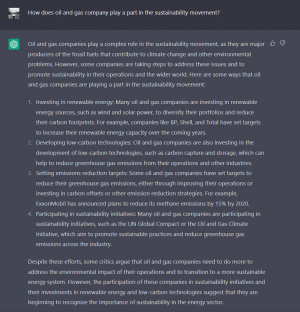Regina Calysta Natalie
Contents
INTRODUCTION
Hello, my name is Regina. I am a student in ECS 2. This will be my page regarding ECS2.
FULLNAME: Regina Calysta Natalie
STUDENT NUMBER: 1906315834
ECS 2 / 21 February 2023 / Correlations between Industries and Energy
After chatting with chatGPT regarding relations between each type of factory with oil and gas company, as shown in the picture below, the chatGPT has replied with an exciting answer.
In conclusion, the industries shown have various relationships with oil and gas companies. There can be a close relationships between factories such as sugar factory and oil and gas company as they both produce ethanol therefore biofuels will be a significant part of the transportation sector. Additionally, a strong correlation exists as the automotive industry mainly consumes petroleum-based fuels. In short terms, oil and gas companies provide the primary sources of fossil fuels to power up these factories and therefore that it plays a critical role.
After knowing such critical role, then where does oil and gas companies play a part in sustainability energy transition? I asked chatGPT regarding this question, which was the AI's answer.
In conclusion, oil and gas companies have a complex role in the sustainability movement, as they are major contributors to climate change and other environmental issues. Despite this, some companies promote sustainability by investing in renewable energy sources, developing low-carbon technologies, setting emissions reduction targets, and participating in sustainability initiatives. While some argue that more needs to be done to address the environmental impact of these companies, their participation in sustainability initiatives and investment in renewable energy and low-carbon technologies suggest they are beginning to recognize the importance of sustainability in the energy sector.
There is an article worth reading regarding this matter from IEA (International Energy Agency). The Oil and Gas Industry in Energy Transitions
It highlights the challenges and opportunities the oil and gas industry faces in transitioning to a low-carbon energy system. The report also emphasizes the importance of collaboration between governments, the industry, and other stakeholders to address climate change and achieve sustainable energy goals. Several key factors outlines the report including the growth of renewable energy and the need to reduce greenhouse gas emissions. There are also several strategies that the industries can adapt to the changing energy landscape to support sustainability. Overall, this article emphasizes the need for oil and gas industry to take a proactive steps to address the challenges of energy transitions and work towards a sustainable energy usage.
This topic is rather interesting as it is a vast topic which can be discussed endlessly regarding many sections. But as an engineer, creating better technology will help achieve sustainable energy. Still, it will only work if these other sections want the same thing.
Personal Project Progress
23/02/2023
My initial thought is to look at my Honda Jazz and research its fuel consumption based on my usual route, Tangerang to UI. But I am also curious regarding the literal difference from Honda Jazz that uses VTEC and those who do not use VTEC. So I will have a look on that as well.
27/02/2023
Ever since classes have started going on offline, my only main way of transport is by going on in car or going on a train. But since most of my classes started early, I decided to go on by my car. Only after regularly using my car from Monday to Friday, I then realized how much in terms of price that I need to fill up my whole tank. My car is 2016 All New Honda Jazz with automatic transmission which can be seen down below.
This Honda Jazz generally has a capacity of 40L of fuel for the tank itself. The distance from my house to my campus is considered pretty far around 50 km for one ride and another 50 km which totals into around 100~110 km of distance. Back in late 2022, I noticed that my fuel usage is considered pretty economic since the ratio that I typically get is around 1 L for around 16~17 km. But lately, there has been changes in the fuel consumption.
My personal project for this course is to investigate what could be the trigger for this change from literature review and also looking at the engine performance itself based on the last shop visit. Other than that, I will also take a look on the analysis between whether or not VTEC engine also plays a part in the fuel consumption itself.
For the calculation, I will try to look for fuel consumption modeling using Modelica based on this article: Package PowerTrain: A Modelica library for modeling and simulation of vehicle power trains
Resume 24/02/2023
I haven't installed OpenModelica so for today, I only took notes on what we did today.
Today, we received a tutorial regarding OpenModelica for IC Engine with Bang Tanwir. IC Engine is an internal combustion engine with fuel and air to be combusted with power and fuel gasses output. IC Engine also needs cooling with refrigerant. In OMEdit, there is a library that consists of IC Engine, therefore we can import the library. Here are the steps for IC Engine modelling in Open Modelica:
1. Open OM. Import the Library. The library name is ThermoSysPro 3.1 or ThermoSysPro 3.2 -> package.mo
2. Create new modelica class "c_engine".
3. Drag the Engine to the workplace.
4. For the left and right, we add the cooling: can be air or water
5. FuelSourcePQ (inside Boundary Conditions) is added to the source inlet or gas connector.
6. SourcePQ is connected to the air inlet for water cooling.
7. SourcePQ is connected to the cooling inlet.
8. Seek is connected to the right side of the cooling (outlet).
9. Add Singular Pressure Loss (shapes like an hourglass) in the middle between Source PQ and cooling inlet and in the middle of the cooling outlet and seek.
10. Input the variables based on the reference. A reference that can be looked at: Study Case IC Engine in CCIT



